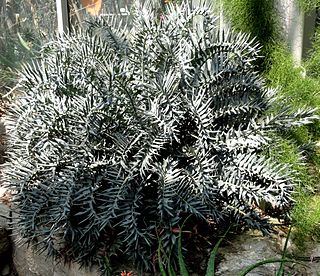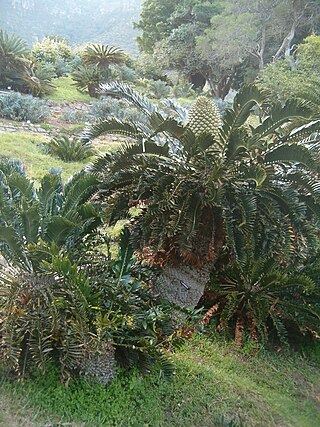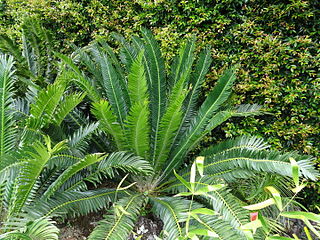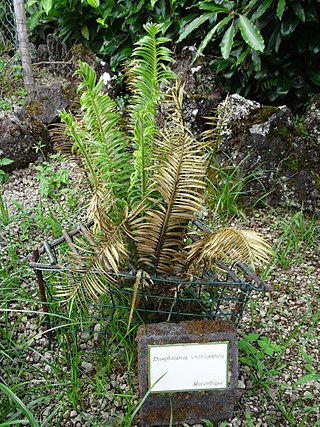
Encephalartos horridus, the Eastern Cape blue cycad, is a small, low-growing cycad up to 0.9 m (3.0 ft) high and 0.9 m (3.0 ft) wide. It is a native of Eastern Cape Province, South Africa, and found in arid shrublands, most commonly on ridges and slopes with shallow soils. The species is particularly known for its distinctly blue-gray leaves, although the degree of coloration can vary significantly. The species name horridus is Latin for 'bristly', after the plant's stiff, spiny leaflets.
Encephalartos brevifoliolatus, the escarpment cycad, is a cycad in the African genus Encephalartos. It is extinct in the wild. The escarpment cycad was found in short grasslands in the very open Protea savanna on the northern Drakensberg escarpment in South Africa's Limpopo Province. These plants are used to growing on large cliffs.

Encephalartos lebomboensis is a species of cycad in the family Zamiaceae. Native to the Lebombo Mountains of South Africa, the species was first described in 1949 by the South African botanist Inez Verdoorn. It is commonly known as the Lebombo cycad, although the name is also used for Encephalartos senticosus which also occurs in the same locality.

Encephalartos whitelockii is a species of cycad that is native to Uganda.

Encephalartos pterogonus is a species of cycad that is native to Mount Mruwere and adjacent mountains in the Manica province of Mozambique.

Encephalartos paucidentatus is a species of cycad.

Encephalartos latifrons is a species of cycad that is native to Eastern Cape province in South Africa at elevations of 200 and 600 metres.

Encephalartos natalensis, the Natal cycad or giant cycad, is a species of cycad that is endemic to the Qumbu and Tabankulu areas of the northern part of the Eastern Cape, and through most of KwaZulu-Natal. The number of mature individuals of this species is declining and the International Union for Conservation of Nature has assessed its conservation status as being "near threatened".

Encephalartos gratus is a species of cycad that is native to Malawi and Mozambique.

Encephalartos concinnus is a species of cycad in the family Zamiaceae. It is endemic to Zimbabwe. It is known as the Runde cycad.

Encephalartos barteri is a species of cycad that is native to Benin, Ghana, Nigeria, and Togo.

Encephalartos arenarius is a species of cycad in the family Zamiaceae. It is endemic to South Africa, where it is limited to the Eastern Cape. Its common names include Alexandria cycad and dune cycad.

Encephalartos manikensis is a species of cycad that is native to Mozambique and Zimbabwe.

Encephalartos hildebrandtii is a species of cycad in the Zamiaceae family. It is native to Kenya and Tanzania at elevations from sea level to 600 metres (2,000 ft). The species is named for the German explorer Johann Maria Hildebrandt.

The Chimanimani cycad is a species of cycad that is endemic to the Chimanimani Mountains of eastern Zimbabwe. It is a threatened species which has been locally extirpated by cycad collectors.
Encephalartos macrostrobilus is a species of cycad in Africa. It is found only in Moyo District, northwestern Uganda, which is populated predominantly by the ethnic Madi.

Encephalartos septentrionalis, the Nile cycad, is a species of cycad in South Sudan, northern Uganda, northern Democratic Republic of the Congo, and the interior of the Central African Republic.
Encephalartos heenanii is a species of cycad in Southern Transvaal Province, South Africa.

Encephalartos humilis is a species of cycad in the former Transvaal Province, South Africa.

Encephalartos umbeluziensis is a species of cycad from Africa.

















